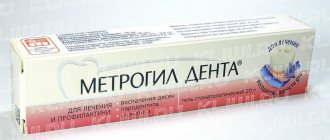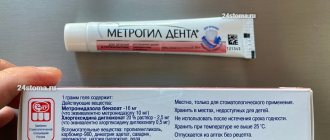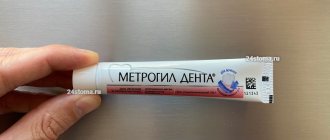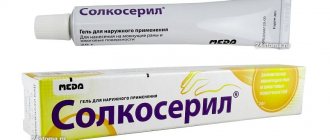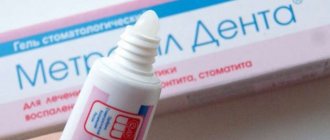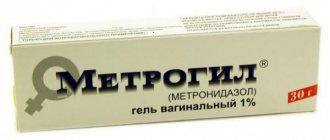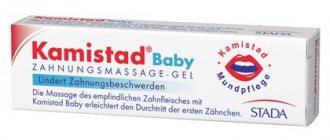Pharmacological properties of the drug Metrogyl vaginal gel
Metrogyl vaginal gel (metronidazole; 1-(β-oxyethyl)-2-methyl-5-nitroimidazole) is an antiprotozoal and antibacterial agent for vaginal use. Highly active against anaerobic bacteria (bacteroides, fusobacteria, clostridia, anaerobic cocci) and protozoa ( Trichomonas vaginalis, Entamoeba histolytica, Lamblia ). Active against most strains of microorganisms that cause bacterial vaginosis: Gardnerella vaginalis, Bacteroides spp., Mobiluncus spp., Peptostreptococcus spp. Aerobic microorganisms are insensitive to metronidazole. The mechanism of action is due to the biochemical reduction of the 5-nitro group of metronidazole by intracellular transport proteins of anaerobic microorganisms and protozoa. The reduced 5-nitro group of metronidazole interacts with the DNA of microbial cells, inhibiting the synthesis of their nucleic acids, which leads to the death of bacteria. After a single vaginal injection of 5 g of vaginal gel, the average maximum concentration of metronidazole in the blood serum of healthy women reaches 237 ng/ml, which is 2% of the average maximum concentration of metronidazole (12.785 ng/ml) when taken orally at a dose of 500 mg. The time to reach maximum concentration is 6–12 hours after a single vaginal injection of 5 g of gel and 1–3 hours after oral administration of metronidazole at a dose of 500 mg. The relative bioavailability of metronidazole in the form of a vaginal gel is 2 times higher than the bioavailability of metronidazole in the form of vaginal tablets (500 mg), which is due to the high penetrating ability of the drug. Therefore, the therapeutic effect of the vaginal gel is achieved at a lower concentration of metronidazole. A lower dose of vaginal gel results in lower serum metronidazole concentrations, which is accompanied by a much lower incidence of side effects.
Metrogyl plus 50g vaginal gel with applicator 10 pcs.
pharmachologic effect
Antimicrobial and antiprotozoal agent + antifungal agent.
Composition and release form Metrogyl plus 50g vaginal gel with applicator 10 pcs.
Gel – 1 g.:
- Active ingredients: Metronidazole 10.0 mg; Clotrimazole 20.0 mg;
- Excipients: benzyl alcohol 40 mg, disodium edetate 0.50 mg, carbomer-940 10.0 mg, methyl parahydroxybenzoate 1.50 mg, sodium hydroxide 2.0 mg, propyl parahydroxybenzoate 0.50 mg, propylene glycol 50.0 mg, water . required, up to 1.0 g.
30 g in an aluminum tube or a plastic laminated tube, the neck of which is sealed with an aluminum membrane and a screw-on polyethylene cap with a protrusion for perforating the membrane. One lip along with an applicator and instructions for use in a cardboard box.
50 g in an aluminum lip or laminated plastic tube, the neck of which is sealed with aluminum foil laminated with polyethylene and with a polypropylene screw cap with a protrusion (or without a protrusion) for perforating the foil. One tube in a cardboard box along with an applicator and instructions for use.
50 g in an aluminum tube or laminated plastic tube, the neck of which is sealed with aluminum foil laminated with polyethylene and with a polypropylene screw cap with a protrusion (or without a protrusion) for perforating the foil. One tube in a cardboard box along with applicators, in the amount of 10 pieces, instructions for use.
Description of the dosage form
Homogeneous opalescent gel of white or almost white color.
Directions for use and doses
Intravaginally.
The recommended dose is 5 g (one full applicator) 2 times a day (morning and evening).
The course of treatment is 5 days. If necessary, the course of treatment can be repeated after 2 weeks.
Pharmacodynamics
A combined drug for intravaginal use, the effectiveness of which is due to the presence of two active components in its composition: metronidazole and clotrimazole.
The mechanism of action of metronidazole is the biochemical reduction of the 5-nitro group by intracellular transport proteins of anaerobic microorganisms and protozoa. The reduced 5-nitro group of metronidazole interacts with the DNA of microbial cells, inhibiting the synthesis of their nucleic acids, which leads to the death of bacteria. Active against Trichomonas vaginalis, Entamoeba histolytica, Gardnerella vaginalis, Giardia intestinalis, Lamblia spp., as well as obligate anaerobes Bacteroides spp., (including Bacteroides fragilis, Bacteroides thetaitaomicron, Bacteroides vulgatus), Fusobacterium spp., Veillonella spp. ., Prevotella (Prevotella bivia, Prevotella buccae, Prevotella disiens) and some gram-positive microorganisms (Eubacterium spp., Clostridium spp., Peptococcus spp., Peptostreptococcus spp.) The minimum inhibitory concentration (MIC) for these strains is 0.125 - 6.25 μg/ml. Aerobic microorganisms and facultative anaerobes are insensitive to metronidazole, but in the presence of mixed flora (aerobes and anaerobes), metronidazole acts synergistically with antibiotics effective against common aerobes. Clotrimazole is an imidazole derivative. Has a fungicidal effect. Reduces the synthesis of ergosterol, which is an integral part of the cell membrane of the microbial wall, and leads to a change in its structure and properties. In small concentrations it acts fungistatically, and in large concentrations (more than 20 μg/ml) it is fungicidal, and not only on proliferating cells. At fungicidal concentrations, it interacts with mitochondrial and peroxidase enzymes, resulting in an increase in the concentration of hydrogen peroxide to a toxic level, which also contributes to the destruction of fungal cells. It has high activity against pathogenic dermatophytes (Trichophyton mentagrophytes, Microsporum canis, Epidermophyton floccosum), yeast and mold fungi (genus Candida, Torulopsis glabrata, genus Rhodotorula, Pityrosporum orbiculare).
Pharmacokinetics
After intravaginal administration, metronidazole undergoes systemic absorption (about 56%). The relative bioavailability of the vaginal gel is 2 times higher than the bioavailability of a single dose (500 mg) of metronidazole vaginal tablets. Penetrates into breast milk and most tissues, passes through the blood-brain barrier and placenta. After a single intravaginal administration of 5 g of gel (50 mg of metronidazole), the average maximum concentration in the blood serum of healthy women is 237 ng/ml, which is 2% of the average maximum concentration of metronidazole when taken orally at a dose of 500 mg. The time to reach maximum concentration is 6 - 12 hours. Communication with plasma proteins is less than 20%. Metabolized in the liver by hydroxylation, oxidation and glucuronidation. The activity of the main metabolite (2 - oxymetronidazole) is 30% of the activity of the parent compound. Excreted by the kidneys - 60 - 80% of the dose of the systemic drug (20% of this amount unchanged), by the intestines - 6 - 15% of the dose of the systemic drug.
When using clotrimazole intravaginally, no more than 3-10% of the administered dose is absorbed. High concentrations in vaginal secretions and low concentrations in blood persist for 48 to 72 hours. In the liver, clotrimazole is rapidly metabolized to inactive metabolites.
Indications for use Metrogyl plus 50g vaginal gel with applicator 10 pcs.
Bacterial vaginosis of various etiologies, confirmed by clinical and microbiological data; candidiasis vulvitis and vulvovaginitis, urogenital trichomoniasis.
Contraindications
Hypersensitivity to the components of the drug. Leukopenia (including history), organic lesions of the central nervous system (including epilepsy), liver failure, menstrual period. Pregnancy I trimester, lactation period.
Application Metrogyl plus 50g vaginal gel with applicator 10 pcs. during pregnancy and breastfeeding
The use of the drug in the second and third trimester of pregnancy is possible only for health reasons, if the potential benefit to the mother outweighs the risk to the fetus. When prescribing the drug during lactation, breastfeeding must be stopped.
special instructions
Simultaneous treatment of sexual partners is recommended.
During the course of treatment it is necessary to abstain from sexual activity.
For vaginitis caused by Trichomonas vaginalis, it is advisable to simultaneously treat the sexual partner with metronidazole for oral administration. If the drug is used together with metronidazole for oral administration, especially with a repeated course, monitoring of the peripheral blood picture is necessary (danger of leukopenia).
During the treatment period, alcohol intake is contraindicated (a disulfiram-like reaction may develop: cramping abdominal pain, nausea, vomiting, headache, sudden rush of blood to the face).
Metronidazole can immobilize treponemes and lead to a false-positive Nelson test.
Avoid contact with eyes!
Impact on the ability to drive vehicles and operate machinery
The drug does not affect the ability to drive vehicles or engage in other potentially hazardous activities that require increased concentration and speed of psychomotor reactions.
Overdose
There have been no cases of overdose when the drug is prescribed in recommended doses.
Side effects Metrogyl plus 50g vaginal gel with applicator 10 pcs.
Local reactions: Itching, burning and hyperemia of the mucous membrane of the external genitalia; in the sexual partner - a burning sensation or irritation of the penis, frequent urination.
Possible systemic effects: Dizziness, headache, dry mouth, changes in taste, including a “metallic” taste, nausea, vomiting, decreased appetite, abdominal cramps, constipation or diarrhea, dark urine, leukopenia or leukocytosis .
Allergic reactions: Skin rash, urticaria.
If any unwanted side effects occur, you must stop treatment and consult a doctor!
Drug interactions
For intravaginal use only!
Similar to disulfiram, it causes ethanol intolerance.
Enhances the effect of indirect anticoagulants; it is not recommended to combine with non-depolarizing muscle relaxants (vecuronium bromide).
When taken simultaneously with lithium preparations, the concentration of lithium in the blood plasma may increase.
Phenobarbital accelerates the metabolism of metronidazole due to the induction of microsomal liver enzymes, cimetidine reduces it, which can lead to an increase in its concentration in the blood serum and an increased risk of side effects.
Amphotericin B, nystatin, natamycin reduce the effectiveness of clotrimazole when used simultaneously.
Drug interactions Metrogyl vaginal gel
When using Metrogyl vaginal gel topically, the interaction with other drugs is insignificant, however, when administered simultaneously with certain drugs, caution should be exercised: metronidazole enhances the effect of indirect anticoagulants, leading to an increase in prothrombin time; simultaneous use with disulfiram can lead to the development of neurological symptoms, so Metrogyl should not be prescribed to patients who have taken disulfiram over the past 2 weeks; Cimetidine inhibits the metabolism of metronidazole, which may lead to an increase in its concentration in the blood serum and an increased risk of side effects.

